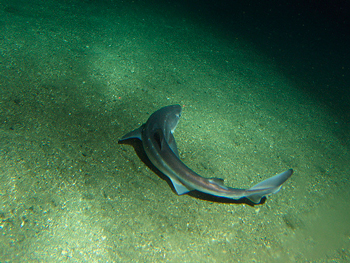Dogfishing Steady,
But Better
Info Needed
by Laurie Schreiber

Dogfish proliferate rapidly, are voracious consumers of other species and grow to more than 4' in length. NOAA photo
PORTLAND—Mechanical problems during the 2014 trawl survey resulted in a data gap for spiny dogfish.
So although the stock appears to be in good shape—it’s not overfished, and no overfishing is occurring—the New England Fishery Management Council (NEMFC) will seek additional information to bolster their understanding of the resource.
According to a NEFMC presentation at its Dec. 1-3 meeting, the most significant sources of scientific uncertainty include:
• The incomplete 2014 Northeast Fisheries Science Center bottom trawl survey.
• Efficiency of the survey gear in developing minimal swept area estimates of biomass.
• Inter-annual differences in availability of the stock to the survey gear.
• Projection model assumption of time-invariant selectivity estimated from data up to 2008.
• Assumption of constant pup survival and pup production rates.
• Total discard estimates and estimated mortality of discarded dogfish.
In 2016, data will include:
• Discard rates,
• Survey abundance trends (size composition, sex ratio and pup size),
• Average size and sex in commercial landings,
• Agreement between observed and predicted catch and survey forecasts,
• Changes in Canadian landings,
• Spatial distributions of catch and survey abundances.
The fishing year starts May 1. As of early December, landings were less than 50 percent of the fishery quota, although fishermen haven’t had a problem catching their catch limit, NEFMC staffer Jason Didden told NEFMC.
“People want a slow and steady approach as much as possible,” Didden said. “Their marketing depends on stability.”
Stock biomass has been on a decline, which is projected to continue from 2016 to 2019, due to a gap in pup production in the early aughts, Didden said. Eventually, he said, recruitment will return to its normal status.
“Their marketing depends
on stability.”
– Jason Diddon, NMFS
According to NEFMC information, spiny dogfish is managed jointly by the Mid-Atlantic Fishery Management Council (MAFMC) and NEFMC. The small shark inhabits the North Atlantic and North Pacific oceans, migrating north in the spring and summer and south in the fall and winter.
In the winter and spring, they congregate primarily in Mid-Atlantic waters but also extend onto the shelf break of southern Georges Bank. In the summer, they’re located farther north in Canadian waters and move inshore into bays and estuaries. By autumn, dogfish have migrated north with high concentrations in Southern New England, on Georges Bank, and in the Gulf of Maine. They remain in northern waters throughout autumn until water temperatures begin to cool and then return to the Mid-Atlantic.
Before 1976, foreign fleets caught the majority of dogfish in U.S. waters. The National Marine Fisheries Service (NMFS) encouraged commercial fishermen to target the bountiful stocks of spiny dogfish in the 1980s and 1990s, when stocks of other commercially valuable fish in the Northeast declined. In 1998, NMFS determined that spiny dogfish were overfished and implemented stringent harvest restrictions in federal waters to allow the stock to rebound. The states followed shortly after with complementary regulations for state waters.
Today, commercial fishermen catch spiny dogfish using longlines, trawls, and purse seines. Fishermen target female dogfish because the females grow larger than males and tend to school together. Processors prefer the larger dogfish because they’re easier to hold and cut. The commercial fishery supplies the European food fish markets that use dogfish “belly flaps” for fish and chips in England and as a popular beer garden snack called shillerlocken in Germany. There’s also a small scientific fishery in Maine, which uses spiny dogfish to study several of the species’ unique biological characteristics. Dogfish have an organ called a rectal gland whose study helps scientists better understand the function of human kidneys. They also secrete a molecule called squalamine, which has strong antibiotic characteristics and shows promise as an anticancer agent.
Landings were approximately 37.2 million pounds in 1992, gradually increasing to a peak of about 60 million pounds in 1996.
By the early 2000s, landings declined to less than five million pounds, then ranged between two and eight million pounds between 2003 and 2009.
With new management measures, the stock improved and landings increased to 21 million pounds in 2011. A maximum possession limit of 5,000 pounds per day for the northern region states (Maine through Connecticut), became effective in 2014. Southern states can set their own possession limits.
The 2014/2015 commercial quota was 49 million pounds, with a trip limit of 5,000 pounds. The 2015/1016 quota is set at 50.6 million pounds. The quota is subdivided into a northern region (Maine-Connecticut) share of 58 percent and state-specific shares for the southern region, allocated to New York, New Jersey, Delaware, Maryland, Virginia, and and North Carolina.
